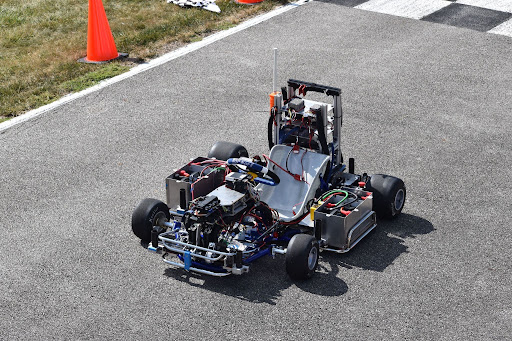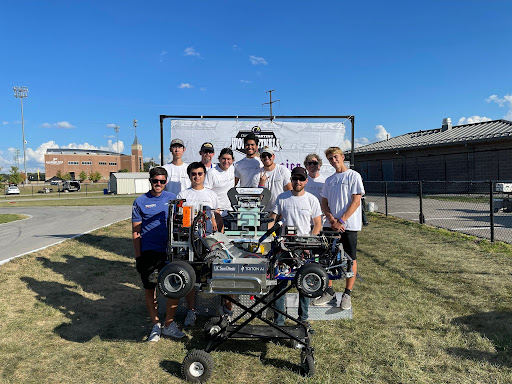News Release
Students make it to finals of first autonomous EV GrandPrix race
September 30, 2021-- A group of UC San Diego engineering and data science students was one of three teams to make it to the final round of the inaugural autonomous EV GrandPrix go-kart race hosted by Purdue University in Indianapolis on Sept. 17. The team, spearheaded by student organization Triton AI, was among 12 university teams who registered to compete with an autonomous go-kart.
The International Electric Go Kart Racing event began in 2010, originally with students building electric go-karts and driving them around a curvy course. This year was the first time that the event included an autonomous version of the race, with students implementing autonomous perception, navigation, and control systems to see which kart could complete roughly one-third of a mile lap on the race track in the fastest time, all on its own.
“The whole concept of it is we build a robot from bottom up-- we just get a go-kart frame and we wire everything together. Then add lidar, add cameras, add radar, and make sure it’s all a complete stack. We built a smaller scale car, basically,” said UC San Diego computer engineering student Jose Jimenez-Olivas.
Along with Jimenez-Olivas, UC San Diego electrical engineering students Jesus Fausto and Dallas Dominguez spent six weeks in Indianapolis this summer developing their go-kart. In addition, Triton AI members Siddharth Saha, Vladimir Rubtsov, Chris Jensen, Andrew Britten, David He and Haoru Xue (all data science or engineering students and recent graduates) provided key support leading up to the race.
To qualify for the final race day, teams had to demonstrate that their go-kart could autonomously complete three laps around the race track. On Sept. 17, the three teams that qualified took turns racing a lap for the fastest time. During the race, the UC San Diego robot’s steering mechanism broke, leading to a third place finish. Though this wasn’t their desired outcome, the students said it highlighted how tricky this competition was; while previous human-driven races have focused on edging out the competition by margins of less than a second, this autonomous version posed more of a challenge.
 |
| The students developed an autonomous go-kart, no driver required. |
“Part of what is exciting about this is that stuff usually doesn’t work,” said Fausto. “Especially since this is the first year it’s autonomous, it’s alright how much of this is gonna work, how much is not gonna go well. That’s kind of exciting. Because rather than going to a competition where every year everyone is going to complete this and it’s all gonna go perfectly, we’re all hacking it together as we go.”
Fausto and Dominguez got their start in this space as students in the Introduction to Autonomous Vehicles course at UC San Diego, where students build small autonomous cars, and race them around short tracks on campus. Jimenez-Olivas never took the course, but has a strong personal interest in cars and autonomy, even turning a go-kart frame he found at the dump into an autonomous vehicle on his own. Even with all this previous experience, the students said this EV GrandPrix competition was a step up.
“The 1/10 scale cars we built during the Intro to Autonomous Vehicles course worked; you knew it would work based on previous quarters reports,” said Fausto. “Here, half the challenge is just getting the kart to work, before we even start making updates.”
“The class was level one, learning how it all worked; this is like we skipped level two and went right to level three,” said Dominguez. “We’re learning on the fly, but there are skills from the class that we’ve used a lot, like how to navigate a linux environment and how to run certain scripts, so the class did pay off.”
The students designed the go-kart to use GPS waypoint navigation to maneuver around the course. They added radar and lidar systems to the chassis, so that it’s able to detect and avoid objects in its path if it goes off course. The students then programmed an embedded GPU with artificial intelligence to compute the optimal speed and orientation of the go-kart. Once the speed and orientation were calculated in the navigation stack, a controller area network (CAN) message is sent to the hardware stack to actuate the go-kart electronically. The students also programmed an industry grade engine control unit (ECU) with software to receive artificial intelligent CAN messages to communicate to the kart’s electrical nervous system to steer, brake, or accelerate.
“From the bottom stack which we’re working on, these CAN frames say, ‘Based on the perception stack, we want the throttle to be at 50 percent, or we have to turn the steering wheel 30 degrees.’ We’re teaching the robot to do all this autonomously through coding,” said Jimenez-Olivas.
The students say they’ve learned a lot through the months-long process, including the importance of documentation.
“A huge theme we’ve been pushing is the fact that this is the first year of the competition, which makes us the people whose shoulders everyone is going to stand on. We’re making documentation really nice to try and make things easier for whatever aspiring engineering students come next, so they don’t have to start from scratch,” said Dominguez.
 |
| The UC San Diego Triton AI team with their autonomous go-kart. |
“Our Triton AI members were extremely committed and determined to win any placement and represent UC San Diego, additionally becoming the first UC San Diego organization to attend the EVGrandPrix competition,” said Andrew Britten, cofounder of Triton AI and a recent electrical engineering graduate. “It was a great teamwork experience that we all can definitely look back on, and we plan to try again in the future. I personally am very proud of my organization and how far we have come with my best UC San Diego Tritons.”
According to Jack Silberman, a lecturer from UC San Diego’s Contextual Robotics Institute and the group’s advisor, the robot’s challenges were part of what made this such an excellent learning experience.
“You usually do not learn these types of things in a classroom,” said Silberman. “Field robotics competitions represent unique opportunities for students to experience the real-world challenges they will most likely face on their next step outside UC San Diego. We will keep building upon the foundations we laid preparing for the 2021 EV GrandPrix. In fact, we are already preparing to participate in the next autonomous robotics competitions.”
Students interested in getting involved with autonomous robotics can reach out to the Triton AI student organization: https://tritonai.org.
Media Contacts
Katherine Connor
Jacobs School of Engineering
858-534-8374
khconnor@ucsd.edu